
by Dr Manjir Samanta-Laughton | Jul 29, 2020 | Paradigm Revolution, Punk Science, Science
Is a black hole winking at us?
A Galaxy named 1ES 1927+654 became the object of attention for astronomers when it went through a 40-fold increase in brightness in March 2018.
They started discussing ‘winking black holes’. In this article, we discuss what is meant by that and what is really going on.
Ordinary no more?
What was thought to be an ordinary black hole at the centre of a galaxy was surprising scientists who turned their telescopes to study it further.
After that initial brightening, the Black Hole then dimmed, getting 10,000 times less bright in less than a year. It has since become brighter again. Hence the idea that it is winking.
Why so fast?
Current orthodox scientists believe that such changes should happen over thousands of years – but this black hole changed by a factor of 100 over the course of eight hours.
One of the foremost theories for what is going on is that a star has collided with the region around the black hole.
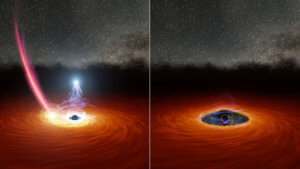
© NASA/JPL Caltech
Mainstream Scientists believe that a star colliding with the area around a black hole is causing it to ‘wink’.
Mystery Solved
However, by understanding, The Black Hole Principle, the mystery is solved. This predicts that the material ejected from the black hole fluctuates in an unpredictable pattern

The Black Hole Principle
We don’t need to evoke any violent or weird situations to explain this. Already mainstream scientists have told us about the amazing abilities of black holes to burp and gobble and they are now saying that they can wink.
It’s simply not necessary if you understand the black hole ‘winking’ as a natural consequence of the process at the edge of our reality.

by Dr Manjir Samanta-Laughton | Jun 17, 2020 | Punk Science, Science
Fast Radio bursts are one of the biggest mysteries in science today.
You may have heard of them because scientists are so stumped as to what is causing them that they are inventing all sorts of theories. Even that they could be alien communications!
So that’s what we are looking at in this episode of Punk Science TV.
An unexpected signal
In 2007 a scientist named Duncan Lorimer was looking over old data from the 1990s for new insights on pulsars when his student found a huge spike that everybody else had missed.
It was a burst of radio waves that had so much power in a short time that it would have taken the equivalent of all the energy of the solar system to produce them.
It wasn’t very certain if they were an artefact or not but after a while, scientists were finding more of these Fast Radio Bursts or FRBs and they are one of the biggest mysteries of space.
Characteristics of FRBs
What we know about FRBs
1. They emit huge amounts of energy in a short time – we are talking about thousands of a second in some cases.
2. They are coming from various places in the universe including our own galaxy.
3. They can sometimes repeat themselves after days or even hours.
Sometimes the source becomes quiet and we haven’t seen them repeat yet.
4. FRBs come in different strengths.
Alien Radio?
Explanations that have been put forward have included everything from alien communication to neutron stars colliding. We also have a favourite – they are being emitted from objects called Magnetars which are like neutron stars with strong magnetic fields.
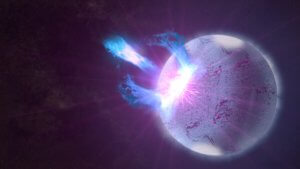
NASA’s Goddard Space Flight Center/S. Wiessinger
(And let’s not forget – these are made-up objects anyway to try and explain the effects we see in space! We haven’t actually seen them directly.)
Chasing the Gamma Rays to the Black Hole
Well, we are now tracking the source of the FRBs and have found that Gamma Ray bursts and X-rays are found in the same area at around the same time.
These are barn door characteristics of The Black Hole Principle.
1. You have the power emitted in a short amount of time, much more than can be explained easily. That’s because the energy is entering into our dimension from infinity.
2. The seemingly random patterns – emission over seconds, hours, days, months or even years can be possible.
It’s the breathing process of the black hole principle that can seem random to us.
3. FRBs are coming from all over space which would be expected as BHP is fractal in nature.
4. And they are associated with gamma-ray bursts and X-rays which I have long spoken about as the consequence of the antimatter, matter and light cycle at the edge of the black hole.

The Black Hole Principle
There are lots of types of energy emitted by BHP and this includes microwaves and radio waves.
Easy and Effortless
You don’t need any weird explanation for FRB. The universe is effortless. It breathes at every level.
So does this mean there are no aliens in space? No! But you don’t need to evoke aliens to explain FRBs when you understand the Black Hole Principle. It all becomes easy.
What do you think? Have FRBs been solved? Leave a comment below.

by Dr Manjir Samanta-Laughton | May 27, 2020 | Punk Science, Science
Conventional Scientists believe that black holes burp on their food! In this episode of Punk Science TV, we explore this concept.
A Ridiculous idea
Scientists tend to think of people like myself as spouting a load of New Age spiritual nonsense. In some cases such as when the word ‘ quantum’ is bandied about amongst healers with no real mind to its actual context in physics, these accusations may have a case.
However, there are times, when mainstream scientists are the ones who come across as ridiculous. So in this example, we are discussing the concept of burping black holes.
The wrong monster
As you may know, the prevailing concept amongst mainstream scientists is that black holes are these great devouring monsters that tear apart stars and anything else that comes too close.
However, once the actual evidence began appearing, it became clear that black holes are visible because they are so bright and that also give off a lot of energy and material.
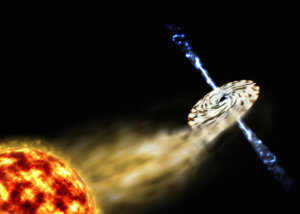
Old Picture of Black Holes, Shutterstock
Burp after the feast
Unable to give up their long-cherished notions that black holes are destructive monsters, these jets that are being emitted from black holes are then turned into ‘burps’.
The idea is that the black hole has feasted and then burps on its food.
This is lazy science.
The Projection game
Rather than realise that their concepts and theories do not match the evidence, they invent ‘burping’ black holes. Human characteristics are being projected onto objects in space as a way of coping with behaviour we don’t understand.
We understand that humans sometimes burp after eating a big meal so we have projected that onto black holes in order to avoid the thorny issue that, according to their own theories, nothing should escape a black hole.
Jets are predicted by The Black Hole Principle
Intermittent jets streaming from black holes are exactly what we would expect in The Black Hole Principle which says that black holes are creative.
We do not need to project any nonsensical ideas onto black holes if we understand that they are just a natural part of the universe unfolding.
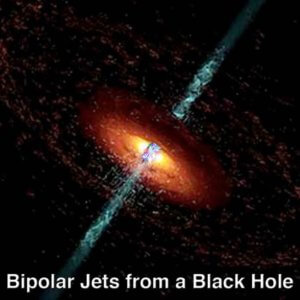

by Dr Manjir Samanta-Laughton | May 24, 2020 | Punk Science, Science
Bizarre though it seems, stars are shooting out water. We take a look at the link with The Black Hole Principle.
This is a topic that I think should be discussed more often; water is ejected from stars in space that are extremely hot. It sounds like science fiction but it is true.
Water has been detected coming from stars including our own sun.
Young star ejects water bullets
There is an example of a young star 750 light-years from Earth which is ejecting water jets from its poles at a speed of about 124,000 miles per hour. ESA’s Herschel Space Observatory, which spotted this, seems to have detected water in liquid form before it vapourised. Then it became liquid again once it had travelled far from the star.

Is it raining on the sun?
Closer to home we have also seen water vapour being emitted from sunspots as early as the 1990s. It isn’t just young and middle-aged stars that have been spotted ejecting water. We have also seen it coming from brown dwarves too.
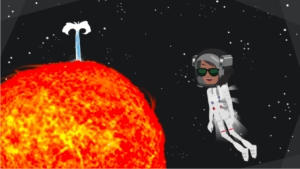
So what is happening?
Predicted by The Black Hole Principle
These findings, which mainstream scientists don’t often discuss, makes total sense in The Black Hole Principle. According to the theory, we see water ejected in jets at every level of the universe. We do indeed have evidence for this. We have witnessed water coming from supermassive black holes in galaxies as well as in thunderstorms (as rain) and geysers here on Earth. It is the same pattern. That’s why both supermassive black holes and our weather systems eject antimatter and gamma rays.
So we would expect stars to be ejecting water. In fact, this is possibly the only scientific theory in the world which expected to see water from stars.
And why from poles and sunspots? Because in the Black Hole Principle the bipolar jet configuration of ejection is quite common. As for sunspots – the sun is in a fractal pattern of black holes. Sunspots are smaller black holes on the larger black hole central to the sun.
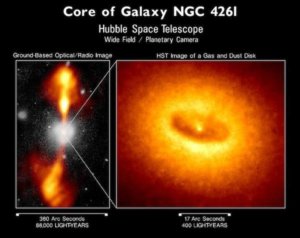
Insights into the theory
These findings also give us some insight into the mechanism of the Black Hole Principle itself. The paper that said that water is found in liquid form near the gas jets from the stars could give us some clue if water is being ejected by The Black Hole Principle fully formed as a molecule. It would suggest it could be.
The concept that stars emit water doesn’t fit the pattern of mainstream science though which is why I think that these findings are not discussed very much if at all.

by Dr Manjir Samanta-Laughton | May 12, 2020 | Punk Science, Science
Wildfires create thunderstorms – are these mini black holes? If so, are they the cause of the fires? Because we know that thunderstorms are created by the same mechanism that creates black holes in the centres of galaxies, the possibility then exists that the lightning exuded by the clouds associated with wildfires could actually be the cause of wildfires and not just a consequence of them.
In this article, I ask the audacious question, do black holes create wildfires?
Wild devastation
In early 2020, the world was rocked by the devastating news that wildfires across Australia had caused massive destruction and the near extinction of some species. It isn’t just Australia which suffers such losses.
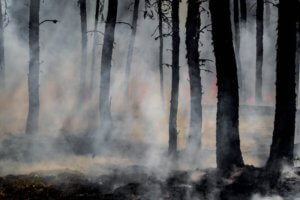
Unsplash
Other countries such as the USA also regularly experience wildfires. It is assumed that there is an initial spark probably caused by the sun or even human carelessness. Vegetation that has dried out provides ample fuel for wildfires to quickly go out of control.
Wildfire storms
There is a phenomenon associated with wildfires that caught my attention: the storms that appear alongside wildfires that can sometimes produce lightning thus spreading the fire even further.
So what is happening here? Conventional science, of course, doesn’t fully understand how lightning is generated as discussed here so wildfire storms are even more poorly understood. In case you are thinking that they are caused by friction and static build-up in clouds, think again as this theory has long been disproved by scientific data.
Dangerous clouds
What we can observe associated with wildfires is that a type of cloud called a Pyrocumulonimbus. It was originally thought that these clouds were rare but now scientists are realising that they are a fairly common occurrence with wildfires. These clouds produce lightning but do not always produce rain.
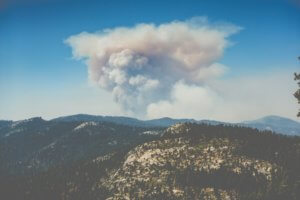
Unsplash
As you can imagine, the lightning from these clouds can ignite further fires and worsening the situation.
But knowing as I do, that thunderstorms show the same characteristics as larger black holes in space, I decided to investigate wildfire storms. What I found was very intriguing.
Intriguing characteristics
Although the pyrocumulonimbus clouds are associated with wildfires, they are very similar to those found around volcanoes. This, of course, is to be expected according to The Black Hole Principle theory, because each level of the universe is working according to the same pattern.
It has also been found that wildfire storms are able to shoot material high into the Earth’s atmosphere, to the point where they have been mistaken for volcanic eruptions.
Again this would fit with the bipolar jet activity that we see associated with black holes from galactic centres all the way down to quarks. These clouds have also been witnessed showing vortex behaviour – similar to a tornado.
Rarely, sometimes there will even be a fire tornado associated with bushfires.
I then found myself wondering, have we got things the wrong way round? Do black holes create wildfires?
The Black Hole Principle and Wildfires
We know that Black Hole Principle activity fluctuates; they are sometimes active, sometimes not. They appear in different areas at different times. This is what gives this and other planets their weather systems.
So maybe what is happening in some wildfires is that black holes themselves initiate in an area, these create lightning which ignites the dry vegetation causing the fire to spread. We see further mini black holes in the area which create the pyrocumulonimbus clouds, lightning strikes, ejection of material high into the atmosphere and sometimes rain.
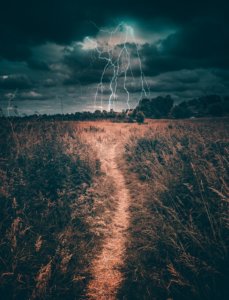
Unsplash
Sure, some wildfires are created for other reasons such as human negligence but effectively the ones created by lightning are being created by mini black holes!
By understanding The Black Hole Principle better, we may be able to manipulate the behaviour of black holes around forests and help to control the initiation of wildfires thus preventing the widespread destruction that they cause.


















